The name “Oaxaca” comes from a Nahjuatl word, huaxyacac (referring to huaje trees, a variety of acacia, and yacatl, or “summit”). The Aztecs applied the name to the summit where they built a fortress in 1486. But the history of Oaxaca goes back 7000 years.
During the pre-colonial period, the present-day State of Oaxaca was home to 16 different cultures with their own languages, customs and traditions. Zapotecs and Mixtecs were the largest and most sophisticated of these cultures. The origins of the Mixtec and Zapotec cultures can be traced to the Monte Albán and Mitla archaeological sites (we visited both places).
In the 15th century, the Aztecs, who lived in the area of what is now Mexico City, made their way south to Oaxaca where they defeated the indigenous populations. By taking control of the Oaxaca Valley, the Aztecs were able to dominate trade routes to South and Central America.
Spanish conquistador Hernán Cortés marched into central Mexico in 1519, and in 1529, the Spaniards established the Villa de Oaxaca on the site of the old Aztec fortress. Spain’s 300 years of colonial rule imprinted Oaxaca, and all of Mexico, with European culture.
Resistance to Spanish rule and the fight for Mexican independence began in 1810. In 1812, royalist forces loyal to Spain besieged the city of Huajuapan—in the northwestern part of the State of Oaxaca. Under the command of Valerio Trujano, 500 insurgents held the city for 111 days against a loyalist army of 1500 until General José María Morelos sent Miguel Bravo’s relief forces to the area to break the siege (we walked on streets in Oaxaca that are named after Morelos, Bravo and Trujano).
In the period 1830-1860, the Liberals and Conservatives fought for control of Mexico’s destiny, and the French intervened on the side of the Conservatives. Benito Juárez, a Zapotec Indian from Oaxaca, led the resistance against the French and shaped Mexico’s future during a period known as La Reforma.
When the Mexican Revolution came in 1910, oaxaqueños sided with the Liberation Army of the South under Emiliano Zapata, a champion of agrarian reform and the rights of the peasants.
In 1987 the UNESCO declared Oaxaca a World Heritage Site due to its beautiful historic colonial buildings, churches and temples.
Getting There
Two shuttle-buses, three airplanes and seven hours of flight time brought us to the city of Oaxaca in May. Our day began at 2:30 AM at our home (4:30 AM Oaxaca time). Due to layovers, we did not touch down at Oaxaca International Airport until about 6:45 PM (Oaxaca time).
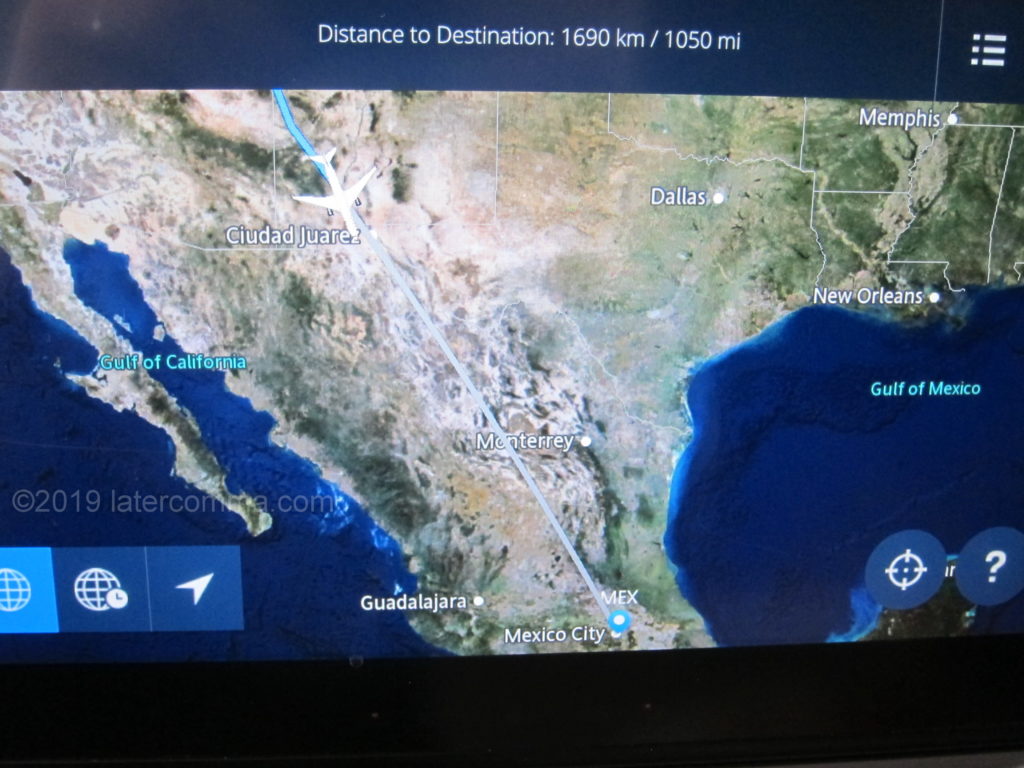
The ride by colectivo (shuttle-bus) from the airport to our hotel convinced me that never in my lifetime would I want to drive in Oaxaca’s crowded streets where traffic lanes are not strictly observed, cars and trucks merge within inches of each other, and traffic control at intersections seems to rely on extrasensory perception. The fare for the colectivo was 180 pesos (less than $10 US).
Hotel Las Golondrinas (the swallows) presents a simple, blue-painted exterior wall to the busy street outside, but inside, we found a beautiful setting of open-air corridors and courtyards filled with fountains, lush plants and flowers. Our room faced one of the courtyards where a collection of tables and chairs served as the breakfast café.
Compared to the standard cookie-cutter hotel room in the US, our room might be called “Spartan” or “rustic.” It had a small foyer, a bedroom and a bathroom with a shower. The floors were red tile or cement. The high ceilings appeared to be made of brick set in several arched bays. There was no television, but the hotel Wi-Fi was good. Although the room had no air conditioning, it had a floor fan, which we used constantly. The staff was friendly and very helpful, considering my limited Spanish.
Day One: Learning the Landmarks
It was a pleasant, sunny morning. After a light breakfast of fruit, coffee and pan dulce, we set off afoot to our first landmark, El Templo de Santo Domingo de Guzman. The plaza in front of the church is a natural gathering spot that we would revisit often during the next eight days. There were always people there, and seemingly always there was some sort of event taking place. That first day, there were a lot of children dressed up for graduation day. In one corner of the plaza, some kind of filming was in progress, maybe for a movie or a commercial of some sort. Maybe because of the filming, there was also an abundance of very serious-looking police officers.
The 400-year-old Templo de Santo Domingo is the city’s tallest building and its spiritual center. Dominican friars began construction in 1572 and construction continued for 200 years. The massive gilded alter was added in 1959. Though the structure is ancient, it is in use. A sign listed multiple services for Sunday mass. We wandered around the plaza and eventually walked inside the church, famous for its ornate decoration, religious paintings and statuary.
Around the corner and in back of the church, we located the entrance to the walled Ethnobotanical Garden, which we planned to visit later in the week. We walked down La Calle Macedonio Acalá, a pedestrian street that connects the Templo de Santo Domingo with another city landmark, the Zócalo. We stopped at a rug shop where we were tempted but did not buy anything. A small detour on Calle de Mariano Matamoros brought us La Casa de Las Artesanias de Oaxaca, a large gift shop where artisans from across the region come together to sell their products, including rugs from Teotitlán, alebrijes (colorful hand-painted wood carvings) and black clay pottery.
Designed by architect Alonso Garcia Bravo, the Zócalo is a one-square-block park in the heart of El Centro (the central historical district of the city). We stopped to take a look at the Catedral Metropolitana de Nuestra Señora de la Asunción, which stands on the north side of the Zócalo. In front of the cathedral is a small park named after General Antonio de Leon, who commanded the Oaxaca National Guard during the Mexican-American War. There is a statue of Antonio in the park.
Opposite the cathedral, on the south side of the Zócalo is the Palacio de Gobierno (Government Palace). Restaurants and shops line the other sides of the park. A large gazebo stands at the center of the Zócalo exposed to the hot sun. Most people sit on iron benches in the shade of huge laurel trees (imported from India) or on the low concrete planter walls that surround the trees. Street vendors are everywhere in the park, and they have constructed a semi-permanent make-shift tent city on the south side of the park in front of the Palacio.
The Zócalo we had read about is a beautiful, pleasant place to sit and pass the time. What we found instead was a crowded, chaotic space with no refuge from obviously desperate people trying to sell us things. We soon tired of saying “no, gracias.”
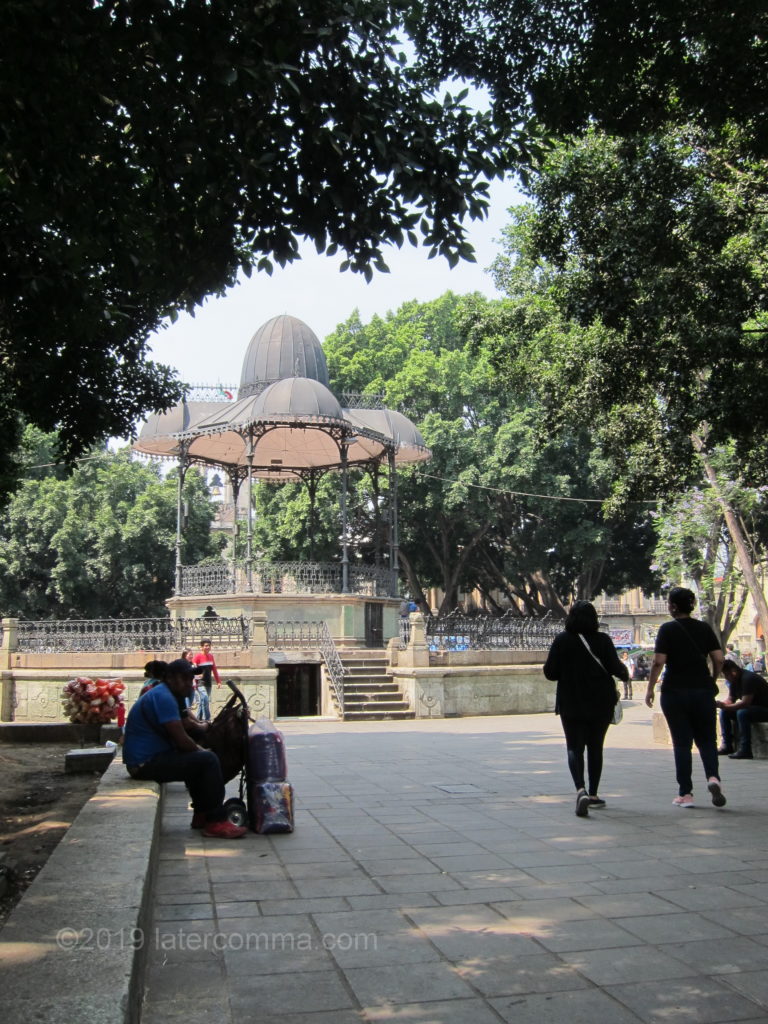
We left the Zócalo to look for the Museo Textil de Oaxaca, and after getting a fix on its location, we decided to find something to eat before touring the museum. We made our way to the Mercado de Benito Juárez, a super-crowded, indoor marketplace where there are hundreds of stalls selling everything from clothing and leather goods to fresh meats and produce. The Benito Juárez Market, open since 1893, is the town’s oldest marketplace. Inside, we found a little café and shared a tlayuda, which in this case was a large, folded tortilla filled with meat, onions, cheese and beans.
After lunch, we went back to explore the textile museum. We were expecting a larger collection, but we enjoyed seeing what was there, including exquisite woven belts from Columbia. On the way back to our hotel, we located the Rufino Tamayo Museum on La Avenida José María Morelos. The museum was closed for the day. That night we had dinner at the Café de Todos Los Santos, a restaurant and chocolate shop across the street from the hotel. The dining area was on a roof-top patio with a city-scape view of the Templo de Santo Domingo. We were the only customers in the place.
Day Two: Monte Albán
The next morning, our tour guide, Edgar Mendoza, picked us up at the hotel at 8:30 and took us to the archaeological site of Monte Albán, about a half-hour drive. When we got out of the car at the site, our ears were assaulted by loud metallic screeching sound, like an old Buick with serious transmission problems. It was just las chicharras (cicadas), Edgar told us, and there must have been hundreds of them in the trees getting all excited about the warm weather.
Edgar was an excellent guide, explaining to us how Monté Alban was constructed and giving us a brief history of the indigenous cultures around Oaxaca. He was also knowledgeable about the trees, plants and animals we encountered.
Monte Albán, the most important archaeological site in the State of Oaxaca, was the capital city of the Zapotec nation and the most important Zapotec site for more than a thousand years. It dates back to 500 BC. At the civilization’s height, Monte Albán exercised political, economic and ideological control over other communities in the Oaxaca Valley and surrounding mountains. Zapotec descendants claim that the hill used to be known as Dhauya quch or Dauyacach (“Hill of the Precious Stones”). It was named Monte Albán in the seventeenth century when the land belonged to a Spanish Lord named Monte Albán (or “Montalban”).
The site covers an area of approximately three square miles and lies 6,400 feet above sea level. The structures that can be seen today likely had religious significance—being on top the top of the ridge and close to the heavens—and also represented the seat of political power for the region. While the ruling elite may have lived near the hilltop, the common people lived lower down on hillside terraces, where they grew maize, beans and squash. Amazingly, the entire area where the monumental structures were built had to be leveled first—by hand. The Great Square alone measures approximately 980 x 650 feet. Pyramid bases, courtyards, and places of worship surround the square where temples and palaces once stood. Approximately 80 percent of the structures visible today have been reconstructed.
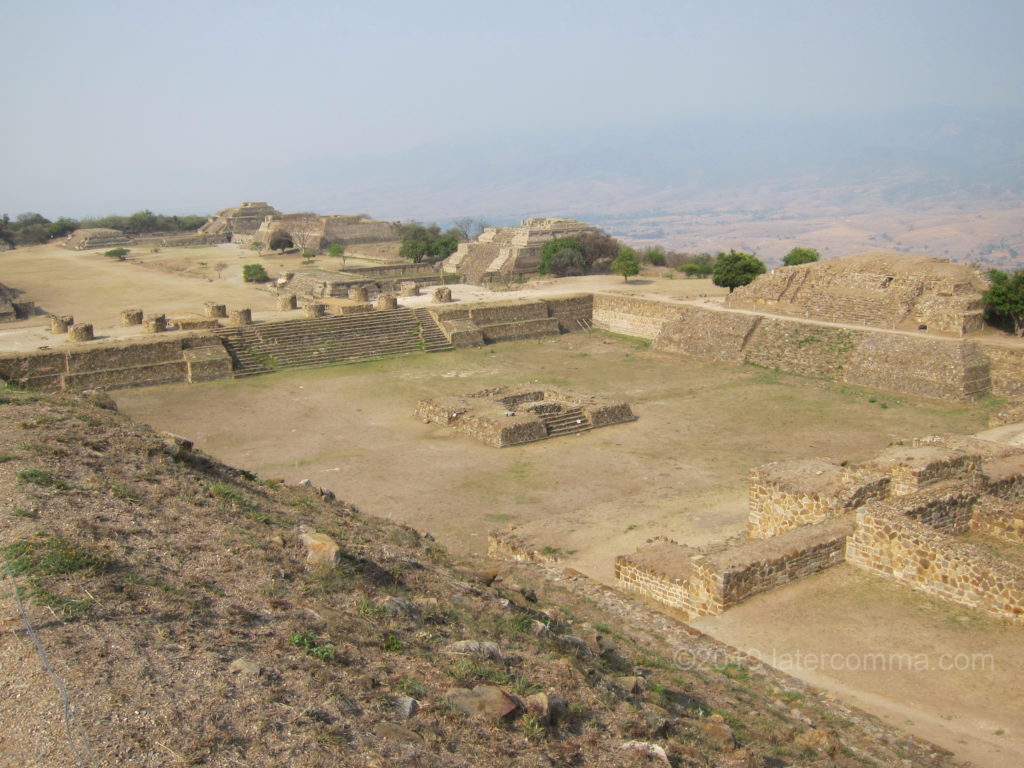
We could not see everything there was to see at Monte Albán, but we were able to get a sense of the place, enough to wonder at how it ever could have been built. We walked through the Great Square, saw the monolithic relief sculptures known as Los Danzantes, climbed up the huge Southern Platform, and looked down on the Ball Court as spectators must have done more than 2000 years ago. We spent some time looking in awe at the artifacts in a small museum at the Monte Albán site before it was time for Edgar to take us back to Las Golondrinas.
That afternoon, we walked through the small house on La Calle de Manuel García Vigil where Benito Juárez lived when he was a young man. Juárez was President of Mexico from 1858 to 1872 and is revered as a progressive reformer dedicated to democracy and equal rights for indigenous peoples. Born to a Zapotec family (his parents died when he was just three years old), he spent his childhood with relatives in the village of San Pablo Guelatao speaking only Zapotec. In 1818 at age 12, he came to Oaxaca where a book binder, Antonio Salanueva, gave him work and shelter and helped with his education. The house is a replica of a 19th century upper class Oaxacan home and includes the book-binding shop along with pictures and memorabilia of Juárez.
A few blocks away from the Casa de Benito Juárez, is the Museo de las Culturas de Oaxaca, where we spent a couple hours touring the museum’s large collection of cultural artifacts in a series of galleries that are arranged chronologically. The museum is housed in the former convent attached to the Templo de Santo Domingo. It was converted into a museum in 1972. It contains some of the finest Zapotec artifacts ever found and includes gold work and treasures extracted from Tomb 7 at Monte Albán.
The multiple galleries in the Museo de las Culturas are filled with so many interesting artifacts that it is impossible to see and appreciate everything in one visit as we tried to do. By the time we had been through every gallery, we were fatigued. We found an isolated bench on the balcony of one of the internal courtyards where we took off our shoes and socks and sat for a brief respite—we had the place to ourselves for those few minutes. After leaving the museum, we went for an early dinner at La Olla, a nearby restaurant.
It may have been on our way back to the hotel that day that we stopped at a small rug shop on La Calle de Ignacio Allende. The proprietor, José, showed us his wares and we both liked a small, rectangular rug that featured Zapotec designs in black, gray, brown, and white wool. We told José that we were not ready to buy anything, but that we would be back.
Day Three: The Best Museum and Our Favorite Dinner
Mexican artist Rufino Tamayo was born in Oaxaca in 1899 of Zapotec ancestry. In 1974, he gave his incredible collection of pre-Columbian art to the city of Oaxaca, forming the Rufino Tamayo Museum of Pre-Hispanic Art. It was part of his life’s work to buy up these artifacts to keep them in Mexico out of the hands of looters. Tamayo died in 1991.
We were impressed by this museum due to the surprising number of objects on display and the beautifully-designed presentation of these unique and priceless artifacts. One of the signs in the museum spoke of the religious significance that these objects had for the indigenous cultures that created them and observed that although the ancient religions have died out, the objects remain to be appreciated for the artistry inherent in them.
We did not see any artworks by Rufino Tamayo himself at this museum—but we were fortunate to see some of his paintings elsewhere later in the week.
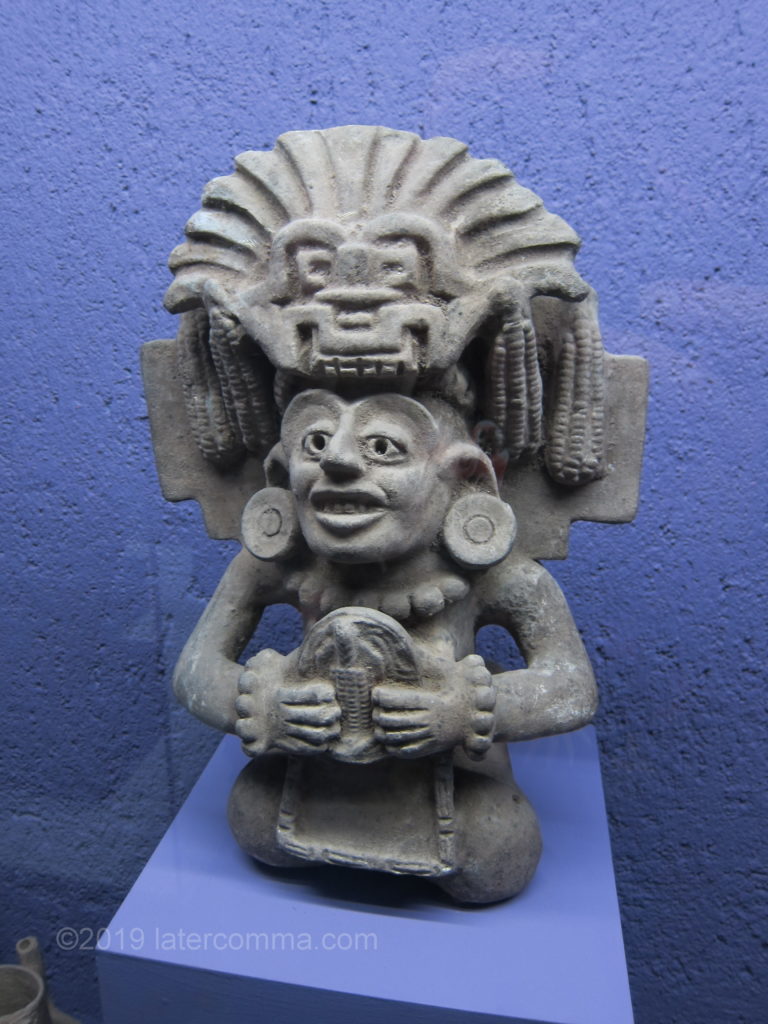
Near the museum, we found the artisan bakery, Boulenc, where we had a light lunch of Aguacate y Cilantro (avocado toast), Croissant de Jamón y Quesillo (turkey ham and cheese on a croissant), and a latte. On the table was a condiment that was new to us—chili oil.
After lunch, we walked to the Mercado de Artesenías on General Ignacio Zaragoza Street. This somewhat scruffy indoor marketplace is packed with an assortment of textiles, clothing and handicrafts for sale. We found a small colorful tablecloth of woven cotton that we liked. The vendor insisted that if we bought it from him it would bring him good luck. We hope that it did.
We crossed the Zócalo on our way to the Museo del Arte Contemporaneo de Oaxaca (MACO). The museum contains contemporary experimental works, such as a large video installation. We found one wall of colorful paintings of funny animals that we liked, but little else appealed to us. There did not seem to be a permanent collection of artworks, and perhaps it was just bad luck that the exhibits on display when we visited were so uninspiring, but MACO was disappointing. We were hoping to find works by Rufino Tamayo, but there were none.
After a siesta at Las Golondrinas, we headed out for dinner, stopping first at a gift store called La Casa de Rebozos. A rebozo is a wide shawl that women can wear in a variety of ways for warmth or to carry bundles—including babies. We selected a bright blue one that measured about 30” x 80”.
We had a lovely dinner at El Asador Vasco, which is located on a second-floor balcony open to the air and overlooking the Zócalo. We found this restaurant on the recommendation of a long-time friend who had visited Oaxaca over 20 years ago. We ordered sea bass and shrimp-stuffed salmon, which were both delicious, and as special treat the restaurant gave us a slice of chocolate birthday cake. As we were finishing dinner, it had started to rain, but we were able to walk back to our hotel without getting too wet. That night, the rain showers turned into a thunderstorm.
Day Four: Mitla
On Friday, Edgar’s partner, Miguel, picked us up at the hotel in the morning for the drive to Mitla, a little over an hour away to the east of Oaxaca. On the way, Miguel pointed out the Benevá Mezcal distillery. The settlement at Mitla dates to the Pre-Classic period (1800-1200 B.C). The ancient ruins of Mitla are located within the modern-day town. Unlike at Monte Albán, most of the visible structures have survived largely intact. The archaeological site has never been fully excavated.
We walked through two areas of the site: the “Church Group” and the “Column Group.” What most impressed us were the remarkable stone mosaics that adorn the walls of the buildings. These distinctive geometric designs were constructed of individual stone pieces fitted together without the use of mortar. The patterns have inspired weaving designs to the present day.
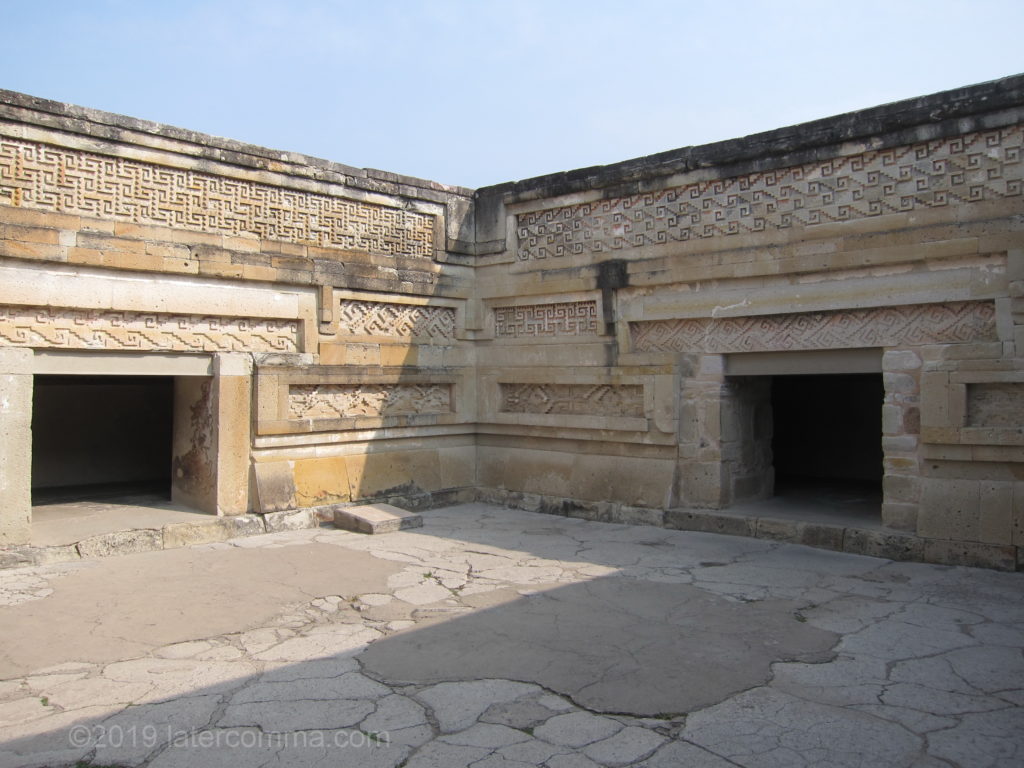
On the way back to Oaxaca, Miguel drove us to the town of Teotitlán del Valle, which is famous for its weavers. We spent most of an hour at Casa ollin, a weaving studio where Viridriana Chávez Bautista explained the process of dying wool with natural colors derived from local plants and showed us how rug weaving is done on several large looms. Beautiful finished rugs were displayed and, of course, for sale. We bought a small rug made by Viridriana’s 11-year-old daughter.
Our final stop before getting back to Oaxaca was in the town of Santa María del Tule, where the famous “Tule Tree” stands. The tree—actually a variety of Montezuma cypress—is believed to have the stoutest trunk of any tree in the world. The tree may be as much as 1,600 years old. In 2005, the circumference of its trunk was measured at 138 feet with a diameter of 46 feet. The tree is about 116 feet tall.
After a little R&R at our hotel, we went out for a repeat visit to Boulenc, the bakery, where we shared a vegetarian sandwich and avocado toast. Both were excellent. After lunch, we walked to the Museo de los Pintores Oaxaqueños (MUPO), which is housed in a 17th Century mansion a block from the Zócalo. Its galleries are arranged around a lovely interior courtyard. The museum is dedicated to showing nationally and internationally known Oaxacan artists. We found it interesting, and the works were of high quality, but nothing really spoke to us. It all seemed dark, moody, and filled with unfocused angst. We wondered why so much contemporary art is this way.
Our experience may have been influenced by the thunderstorm that was brewing in the background and the very large and loud demonstration taking place across the street in the park in front of the cathedral. MUPO has a very nice gift shop, where we bought an alebrije in the form of a frog. Overall, we agreed that MUPO was better than MACO but still disappointing.
We went back to Las Golondrinas, stopping first at an ATM to replenish our peso supply. We were planning to go to dinner at Las Quince Letras, which is near Santo Domingo and which Miguel had recommended, but as dinner time approached the thunder that we had been hearing developed into a heavy rainstorm, and we decided to skip dinner and stay dry.
Views: 29
Some other stuff for later,
- 67Day Five: A Walk in the Garden To compensate for the lack of dinner the night before, we treated ourselves for breakfast at El Escapulario, a tiny, second-floor restaurant located a few blocks from El Templo de Santo Domingo. Because there were few customers, we chose the best table, in…
- 66Leaving Durango, our road trip’s next destination is Buffalo, Wyoming. Our visit to Buffalo completes a circle, linking this road trip to our last big road trip when we visited the town for the first time and stayed at the Occidental Hotel in 2010. The distance from Durango to Buffalo…
- 61We check in at the Durango Lodge for two nights. The motel’s pool is tempting, but dinner is our priority. We take a walk down Durango’s Main Avenue. The centerpiece is a grand old hotel, The Strater, built in 1887. Somewhat less pretentious is the General Palmer Hotel, built in…
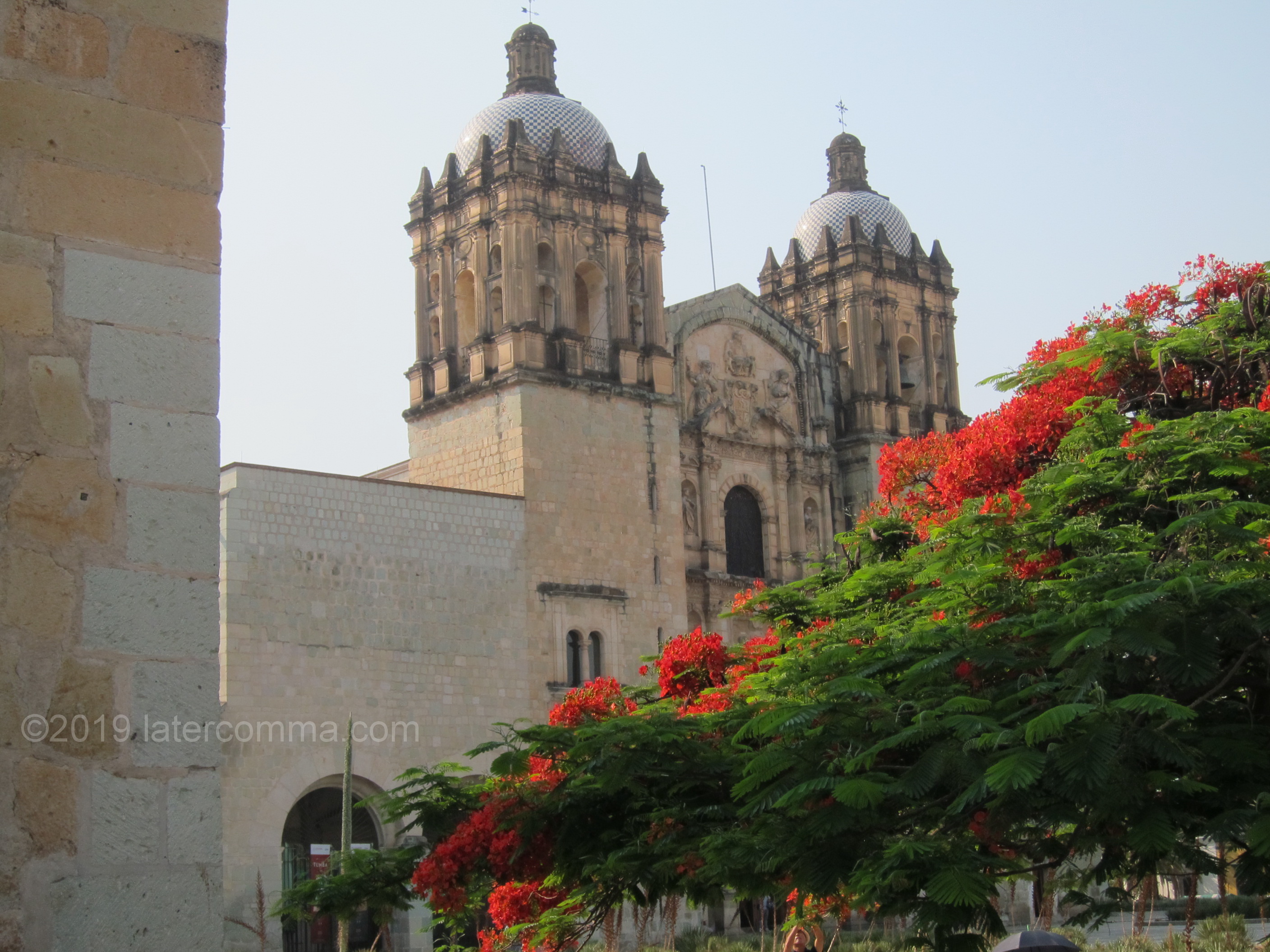
Leave a Reply